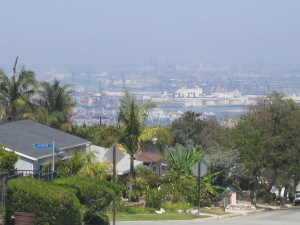Reprinted from Capitol Weekly
Millions of Californians suffered from smog and smoke this summer, but help is on the way. Defying the expectations of many observers and the fierce opposition of the oil industry, the Legislature passed a historic climate protection package in August. What the late-session action showed is that even many of the Assembly Democrats most reluctant to pass sweeping climate bills will vote for a package that includes relief for the communities most burdened by air pollution and disinvestment.
What put SB 32 (Pavley) over the top, with its ambitious target of a 40% reduction in greenhouse gases by 2030, was linkage with AB 197 (Garcia), which combines new mechanisms for legislative involvement in climate policy implementation with directives to the Air Resources Board to reduce both greenhouse gases and local air pollution directly, meaning in the most impacted and disadvantaged communities that bear the brunt of toxic industrial and transportation emissions.
Unofficially linked to the SB 32/AB 197 tandem was a package of bills that will bring real dollars to those same areas. AB 1550 (Gomez) builds on SB 535 (de León) from 2012 by requiring that at least 25% of the investments of money brought in by auctioning carbon allowances be spent in the most disadvantaged communities, with another 10% going to benefit low-income residents. AB 1613 is a budget bill that appropriates $900 million to green programs like clean vehicles, public transit and tree planting, especially in disadvantaged communities; and SB 859, a budget trailer bill, includes reforms that will make the clean vehicle rebate project more equitable and effective and protect communities from adverse impacts of agricultural projects.
California has been blessed with abundant leadership on climate and air policies, and this year’s accomplishments certainly continue that pattern. Senator Fran Pavley, ending her tenure in a blaze of glory, and Senate Leader Kevin de León added to their remarkable legacies of groundbreaking legislation. Governor Brown’s putting his weight behind those senators’ majority-vote strategy was a key turning point in the campaign to pass SB 32 and AB 197. Speaker Anthony Rendon delivered impressive wins even earlier than planned, uniting most of his sometimes-fractious Assembly Democratic caucus, and Assemblymembers Eduardo Garcia and Jimmy Gomez emerged as astute and effective champions of policies that address global warming at the same time as they clean up the air in our most underserved communities.
Most of California’s major environmental laws have been passed in election years, because big bills often take two years to pass, and because voters want their lawmakers to protect air and water. This summer’s Public Policy Institute of CA survey showed that 68 percent of Californians favored SB 32’s goal. While many legislators dance to the tune of Big Oil – like Assemblymember Adam Gray, who signed an anti-ARB letter scripted for him word-for-word by an oil lobbyist – others are mainly interested in bringing tangible benefits, in the form of pollution reductions and green investments, to their districts, and it was those Assemblymembers who provided the votes to give SB 32 the majority that it had lacked last year.
Tip O’Neill’s axiom that “all politics is local” turns out to apply even to global warming, as lawmakers stressed their desire to see cleaner vehicles and greener neighborhoods in their districts. Laudably, Governor Brown loosened up the purse strings and agreed to the Senate’s insistence on investing most of the money already in the Greenhouse Gas Reduction Fund. Much attention has been focused on the paucity of dollars brought in to that Fund by the two most recent auctions of carbon allowances, and it is true that the state’s cap-and-trade system faces serious challenges. What many commentators forget, though, is that cap-and-trade is not an end in itself – it is simply one of many means that the state uses to reduce emissions. Many of the other emission reduction measures, like requirements for cleaner vehicles and fuels, renewable power, and more efficient buildings and appliances, have been working well for years, boosting our economy while cutting pollution, and will continue to work regardless of the fate of cap-and-trade.
So far, California is on track to meet AB 32’s standard; meeting the more ambitious SB 32 level will require rapid and aggressive actions to decarbonize the economy. This campaign will not be easy, but the summer of 2016 will be remembered for the legislation that put us on the path to success.








